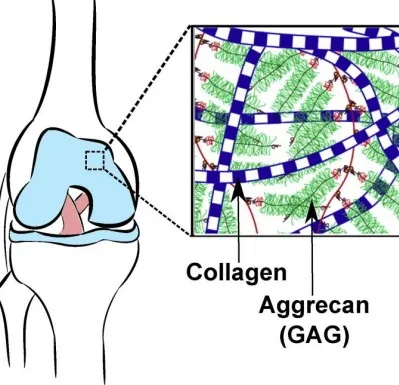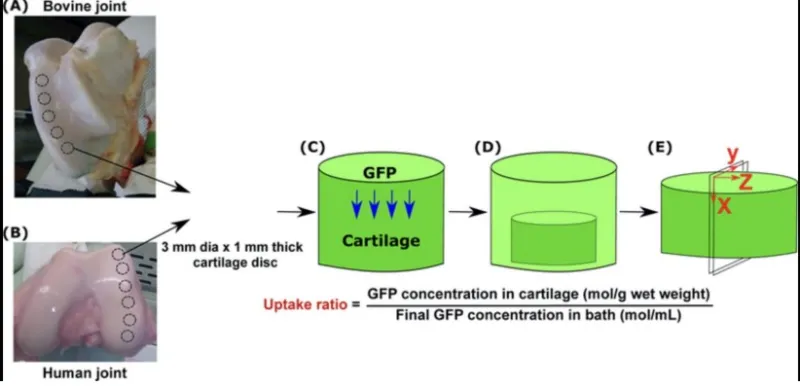Multi-Targeted, Tunable, Sustained Delivery of Drugs and Other Payloads to Charged Avascular Tissues
This technology presents treatment options for tissue-based diseases and disorders resistant to conventional methods due to their location within the body. The compositions leverage the tissue’s naturally occurring negative charge by pairing therapeutics with positively charged carriers for effective, targeted delivery.
Researchers
-
multi-targeted, tunable, sustained delivery of payloads to charged avascular tissues
Patent Cooperation Treaty | Published application -
multi-targeted, tunable, sustained delivery of payloads to charged avascular tissues
United States of America | Published application
Figures
Technology
This technology can deliver the desired treatment molecule to charged avascular or partially vascularized tissue in a variety of ways, including but not limited to locally administered injection, pill, or powder. The treatment molecule (typically a protein, nucleic acid, or antibody) is connected, either directly or with the help of a linker molecule, to the carrier molecule. Carriers can be either synthetic or natural proteins with various net charges and surface charge distributions. However, optimal carriers will vary depending on the target tissue and therapeutic goal.
Once a subject receives an effective amount of a positively charged carrier linked with the treatment molecule, the charge differential between the ECM and the carrier enables the drug to rapidly penetrate the tissue and reside there for a prolonged therapeutic effect.
Problem Addressed
Traditionally, pharmacological therapeutics are distributed throughout the body via blood in the vascular system. However, certain areas of the body like cartilage or intervertebral discs, may consist of solely avascular or partially vascularized tissue. This absence of blood vessels poses challenges in delivering drugs and other molecules/particles into the tissue, especially to the cells, in a sustained manner. As a result, conditions like osteoarthritis, intervertebral disc degeneration, and musculoskeletal diseases become incredibly difficult to treat.
Current methods to reach avascular tissue typically utilize direct intra-articular injection of drugs into the joint fluid. However, in the case of diseases like osteoarthritis, intra-articular injection remains ineffective due to poor cartilage penetration and the rapid lymphatic clearance of the drug from the desired area. This technology overcomes these limitations by leveraging the thickly packed extracellular matrix (ECM) inherent to most avascular and partially vascularized tissue. The ECM primarily consists of connective proteins which form a dynamic network of macromolecules, contributing to the mechanical function of the tissue.
The matrix carries an overall negative charge which repels like charged particles. This allows the composition to pair a positively charged carrier with the treatment molecule to ensure effective delivery of the therapeutic to the desired tissue. As a result, this method improves drug penetration and retention in avascular and partially vascularized tissue.
Advantages
- The use of positively charged carriers improves drug penetration and retention in cartilage.
- This method can be employed to decrease tumor burden, cancer cell quantity, or increase immune activity.
- These carriers can deliver both small molecule drugs and large biologics to cartilage.
Publications
Krishnan, Y., H.A. Rees, C.P. Rossitto, S. Kim, H.K. Hung, E.H. Frank, B.D. Olsen, D.R. Liu, P.T. Hammond, and A.J. Grodzinksy. 2018. "Green Fluorescent Proteins Engineered for Cartilage-Targeted Drug Delivery: Insights for Transport into Highly Charged Avascular Tissues." Biomaterials 183: 218-233.
Bajpayee, A.G., R.E. De la Vega, M. Scheu, N.H. Varady, I.A. Yannatos, L.A. Brown, Y. Krishnan, T.J. Fitzsimons, P. Bhattacharya, E.H. Frank, A.J. Grodzinsky, and R.M. Porter. 2017. "Sustained Intra-Cartilage Delivery of Low Dose Dexamethasone Using a Cationic Carrier for Treatment of Post Traumatic Osteoarthritis." Eur Cell Mater 34: 341-364.
Krishnan, Y., and A.J. Grodzinsky. 2018. "Cartilage Diseases." Matrix Biology 71-72: 51-69.
License this technology
Interested in this technology? Connect with our experienced licensing team to initiate the process.
Sign up for technology updates
Sign up now to receive the latest updates on cutting-edge technologies and innovations.

